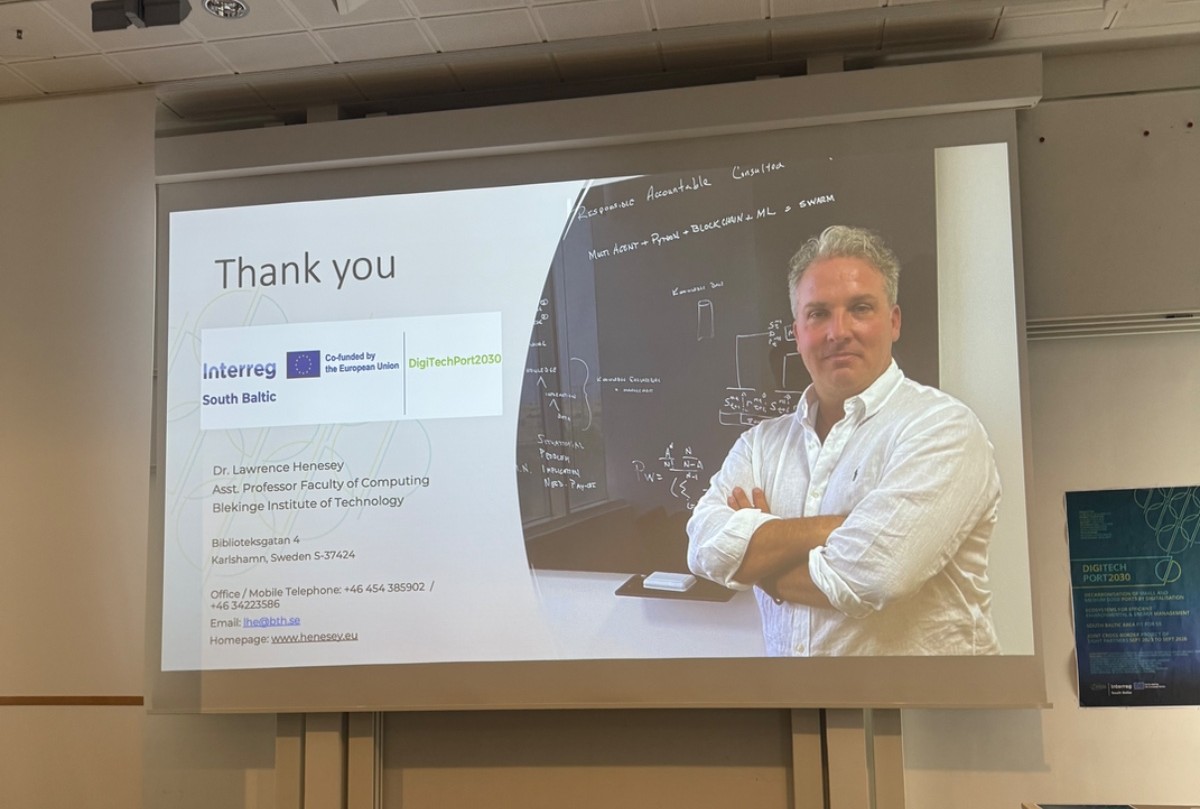At the heart of the DigiTechPort2030 initiative lies a bold ambition: to accelerate green and digital transformation across small & medium-sized ports in the South Baltic region. Blekinge Institute of Technology (BTH) plays a pivotal role in this endeavour – leading Work Package 3 and overseeing the testing of decarbonisation pilots in ports. We sat down with Dr. Lawrence Henesey and his team to explore how applied IT, innovation and sustainability intersect in the maritime domain – and what the real-life implications are for ports moving towards net-zero.
DigiTechPort2030: Blekinge Institute of Technology has a strong background in innovation, digitalization, and sustainability. Could you briefly introduce the university’s main areas of expertise and explain how they connect to maritime and port-related research?
Dr. Lawrence Henesey: At Blekinge Institute of Technology (BTH), our strength lies in integrating applied IT, sustainability science, and systems thinking to address global societal challenges. BTH is ranked among Sweden’s leading universities for sustainability-driven innovation and has long-standing expertise in digitalization, data analytics, and intelligent systems.

My own research (see www.henesey.eu) has for over twenty-five years focused on multi-agent systems, digital twins, and intelligent decision support systems for the maritime and logistics sectors. This work has explored how ports and terminals can use applied AI and simulation to optimize operations, enhance resilience, and reduce emissions.
In this sense, BTH’s mission aligns perfectly with port-sector digitalisation. Our research applies data-driven models, machine learning, and energy-twin frameworks to maritime logistics, helping ports transition toward climate neutrality, in line with the EU’s Green Deal and Fit-for-55 objectives.
DigiTechPort2030: Within DigiTechPort2030, BTH leads Work Package 3 on testing decarbonization pilots. Could you describe what this coordination role involves and how you support partner ports in developing and monitoring their pilot activities?
Dr. Lawrence: As coordinator of Work Package 3, BTH is responsible for designing the methodology and supervising the implementation of the Green Demonstration Pilots across the participating small and medium-sized ports (SMSPs). This includes coordinating with technical partners, municipal stakeholders, and port operators to ensure that pilot activities are measurable, comparable, and replicable.
We provide a scientific and digital backbone to the pilots through simulation-based assessments, digital twin modeling, and energy flow analysis. Drawing on my research in decision support systems and multi-agent coordination, BTH helps partners use digital tools to model CO₂ reduction scenarios, monitor performance indicators, and develop long-term digital roadmaps for decarbonisation.
Practically, this involves creating port energy twins, deploying smart sensors for monitoring, and analyzing baseline energy and emission data. BTH also ensures that pilot results are evaluated using harmonized Key Performance Indicators (KPIs) to facilitate cross-border learning across the South Baltic ports.
DigiTechPort2030: The June 2025 WP3.1 (Green Demonstration Pilot Setup Report in SMSPs) report presented several early results from the ongoing pilots. What are some of the main insights or observations that have emerged so far?
Dr. Lawrence: The initial findings from WP3.1 confirm that digitalisation and decarbonisation must evolve together. Many of the partner ports are now leveraging digital twins, sensor-based monitoring, and predictive analytics to better understand their operational energy footprints.
For instance, pilots in Karlshamn and Świnoujście show how data-driven electrification modelling and simulation of equipment duty cycles can reveal hidden inefficiencies and identify emission hotspots. Another insight is that smaller ports often lack structured data systems; however, by implementing even basic digital energy dashboards and analytics tools, they can quickly achieve measurable progress toward energy savings and CO₂ reduction.

Strong collaboration between port authorities, municipalities, and regional energy agencies has proven vital in creating holistic decarbonisation strategies that extend beyond port boundaries.
DigiTechPort2030: One of BTH’s strengths is using applied IT and data-driven approaches. How do digital tools or smart systems help in analyzing and supporting decarbonization efforts in ports?
Dr. Lawrence: Digitalization allows ports to simulate, test, and optimize their energy and operational systems before making real-world investments. Using the frameworks developed in my research on intelligent decision support systems and multi-agent simulation, we can model complex port operations – from truck gate flows to electrified equipment use – and assess various decarbonisation scenarios.
In the DigiTechPort2030 pilots, BTH has applied digital twin concepts to monitor forklift and reach stacker energy usage. By creating an energy twin of port operations, managers can forecast power demand, evaluate solar and battery integration, and identify optimal charging schedules. Such systems transform raw data into actionable intelligence, enabling ports to base decisions on verified models rather than assumptions.
The integration of AI and machine learning supports predictive maintenance, energy optimization, and emission forecasting – all central to building climate-neutral port ecosystems.
DigiTechPort2030: Working with multiple ports and institutions across countries can be both exciting and challenging. From your perspective, what factors are key to ensuring successful collaboration in such an international, interdisciplinary project?
Dr. Lawrence: In DigiTechPort2030, success relies on three critical pillars: trust, transparency, and technical alignment. With partners spanning Sweden, Poland, Lithuania, Germany, and Denmark, effective communication and shared objectives are fundamental.
BTH plays a bridging role by translating complex digital concepts into operational language that port managers and engineers can apply. Through regular capacity-building workshops, digital twin training sessions, and Living Lab exchanges, we ensure that each partner not only implements but also understands the underlying digital logic behind the decarbonisation tools.
Drawing on prior EU collaboration experience (e.g., AI Know IT, PortWise, DeCoInter), we have learned that long-term partnerships thrive when data-sharing and co-creation are embedded in the process. The South Baltic ports have shown a strong willingness to collaborate openly, making DigiTechPort2030 a genuine example of transnational innovation in practice.
DigiTechPort2030: Looking ahead, how do you see DigiTechPort2030 contributing to long-term change in the maritime sector? Are there areas where you would like to continue developing the research or expand cooperation after the project concludes?
Dr. Lawrence: DigiTechPort2030 is building the foundations for the South Baltic Smart Green Port Network, where each participating port serves as a living laboratory for digital and sustainable innovation. The project’s long-term legacy lies in its transferability – the ability for small and medium-sized ports across Europe to adopt similar methods and technologies.
After the project, I see strong potential to continue through initiatives such as the proposed Centre of Excellence of AI for Sustainable Living and Working (SustainLivWork), which aims to integrate AI-driven sustainability approaches into port-city ecosystems.
Future research at BTH will deepen the use of AI and reinforcement learning in port digital twins, expand cross-sector collaboration with energy providers, and explore blockchain-based carbon accounting for transparent emission tracking. Ultimately, the goal is to help ports transition from isolated digital upgrades toward holistic, data-integrated decarbonisation ecosystems, continuing the momentum created by DigiTechPort2030.

DigiTechPort2030: Thank you for your time!
Keep an eye out for future interviews showcasing the DigiTechPort2030 project partners!
Don’t forget to visit us on LinkedIn for more updates.
